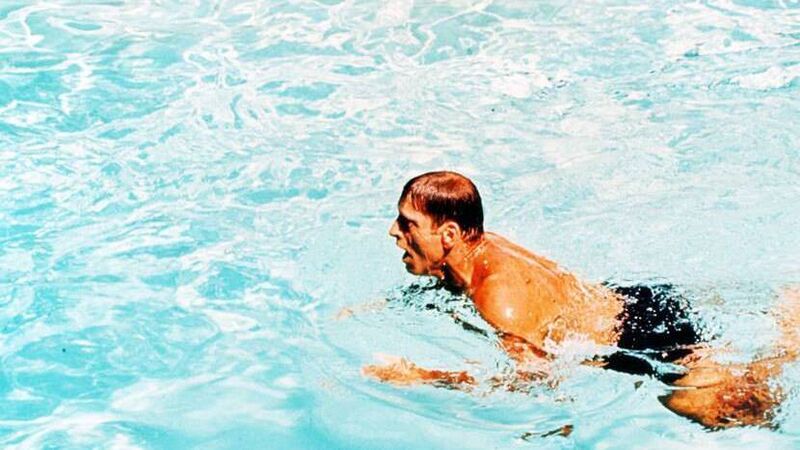Paul Rouse: ‘The Swimmer’ still stands the test of time

Burt Lancaster in The Swimmer (dir. Frank Perry, 1968). The story is a stunning feat of imagination, utterly original.Picture: Columbia Pictures/Photofest
There are some brilliant short stories related to sport, collected in various volumes and perfect for holiday reading. These stories run throughout the history of modern sports and include some of the most famous authors ever to publish works of fiction.
There is John Updike’s description of a baseball player trying to work out the reasons for his disastrous hitting problems in The Slump. And there is an entirely different type of short story in Arthur Conan Doyle’s The Croxley Master.
Doyle’s genius in writing compelling fiction offers a deep insight into Victorian sport — and, in this instance, boxing in particular — in a way that historians struggle to match.
In general, the range of short stories which to a greater or lesser extent have sport as a theme or a context, is reflective of the importance of sport to modern society.
The best of them all might just be John Cheever’s The Swimmer ; it was first published this month in 1964 in The New Yorker magazine (and can now be read off the internet through a google search).
It’s not exactly set in the world of sport, but sport is part of the story; it is a stunning feat of imagination, utterly original.
It was no surprise that the story was soon made into a film – also called The Swimmer — starring Burt Lancaster.
The central figure of the story in Neddy Merrill. We see him first at a warm Sunday afternoon’s poolside party at the Westerhazy house in a wealthy (unnamed) American suburb.
Merrill is described by Cheever as being sporty and fit and full of energy and although well into middle age, “he seemed to have the special slenderness of youth”.
His own house was eight miles to the south and, having thought of his four daughters having their own lunch and maybe playing tennis, he was struck with a remarkable idea.
Basically, he decided to swim home to that house: “In his mind he saw, with a cartographer’s eye, a string of swimming pools, a quasi-subterranean stream that curved across the county. … He was not a practical joker, nor was he a fool, but he was determinedly original, and had a vague and modest idea of himself as a legendary figure. The day was beautiful, and it seemed to him that a long swim might enlarge and celebrate its beauty.”
And he decided to name this stream of swimming pools the Lucinda River, after his wife.
What Neddy Merrill did next was straightforward and something which distances his behaviour from what most of us do when we have daydreams: He actually decided to do what he imagined. And he decided to do it straight away.
“He took off a sweater that was hung over his shoulders and dove in. He had a simple contempt for men who did not hurl themselves into pools. He swam a choppy crawl, breathing either with every other stroke or every fourth stroke, and counting somewhere well in the back of his mind the one-two one-two of a flutter kick.”
And then, having swum the length of the Westerhazy pool, he turned to his wife and told her he was off to swim home.
As Cheever wrote, “he knew that he would find friends all along the way; friends would line the banks of the Lucinda River”
The back of this river were the homes and pools of the wealthy suburban set in which his life had flourished: “First there were the Grahams’, the Hammers’, the Lears’, the Howlands’, and the Crosscups’. He would cross Ditmar Street to the Bunkers’ and come, after a short portage, to the Levys’, the Welchers’, and the public pool in Lancaster. Then there were the Hallorans’, the Sachs’, the Biswangers’, the Shirley Abbott’s, the Gilmartins’, and the Clydes’.”
And so it was that he crossed roads and climbed hedges, appeared across the lawns of these homes. He jogged from pool to pool, dove in, swam, climbed out, chatted people he knew, moved on, stopped for a drink, hugged and kissed, jogged again, swam again: “The gravel cut his feet, but this was the only unpleasantness.” The pools and tennis courts and riding rings of the wealthy are described in passing, as Cheever creates a gripping atmosphere of all manner of social interaction: “This was the day that Neddy Merrill swam across the county.”
The funniest moment is when he comes to the home of his friends, the Hallorans, “an elderly couple of enormous wealth”. This marked the halfway point on his swimming odyssey (and what Cheever basically was doing was taking that oldest literary form, the epic, and recreating it in suburban America).
The other thing to note about this pivotal moment of the story is that the Hallorans had the oldest pool in the neighbourhood and they always swam naked. So Neddy Merrill swam naked too.
But it is at this point of greatest amusement that the story takes a lurch into darkness. Mrs Halloran says: “We’ve been terribly sorry to hear about all your misfortunes, Neddy.”
Mrs Halloran’s air of melancholy when she alludes to the loss of his house and begins an unfinished sentence that suggests something has happened to his daughters, leads Merrill to leave.
From this point on the darkness of the story grows and grows; the closer he comes to home, the worse things get.
The final unravelling is when he arrives at his home. There is nobody there. Indeed, there is actually rust on the doors and the gutters need fixing. Drink and financial ruin had devastated the life he had built.
He shouted and pounded on the door, tried to force it open with his shoulder but then the reality of what was happening was made clear when he looked through a window: He had swum the county but his home was empty.
Five great sporting novels to read this summer
David Storey, This Sporting Life
This novel, set in northern England, tells the story of a man making his way as a professional player in Rugby League.
WP Kinsella, Shoeless Joe
The book which was made into the film Field of Dreams.
David Peace, The Damned United
This “biographical novel” centres on the football manager, Brian Clough, during his 44 days as manager of Leeds United in 1974.
Frederick Exley, A Fan’s Notes
A “fictional novel” which explores the obsession of being a sports fan, engaging with themes such as masculinity, addiction, and mental illness.
Philip Roth, The Great American Novel
A wild tale of a baseball pitcher who once tried to kill an umpire, a first baseman who never hit a home run sober, and on and on…
- Paul Rouse is professor of history at UCD

Unlimited access. Half the price.
Try unlimited access from only €1.50 a week
Already a subscriber? Sign in








